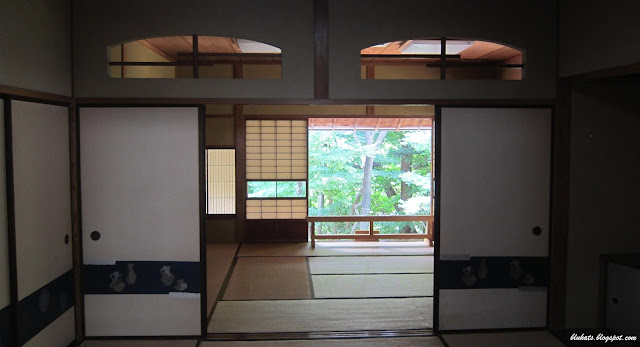The other striking feature of the Kyu Asakura House are the grounds and gardens. Walking in you notice how lush they are.
I'm trying to remember what I was told about the difference between personal and public Japanese gardens. Notable about the Kyu Asakura House are the number of large stone lanterns.
Even more eye catching are the views from inside the house. To me this is one of the most pleasing things about Japanese architecture. The merging of the outside with the inside. I just wanted to sit with a cup of tea and relax.
It also helps psychologically to make one feel cooler in hot weather. Japanese houses were built to deal with hot weather. Cold weather not so much. With views like this it does make it a little more bearable.
The second floor of the house offered views of the lower roofs and gardens. Along with the contrast of the modern buildings that surround it.
Clay tiles cover the roofs which were helpful to protect from fires and easy to replace when earthquakes happened.
The inner courtyard garden. I wonder if the stone grinding wheel was from a rice grinding mill. Since Torajiro Asakura was a rice broker I would assume it was. There was at least one more in the outer garden. Also this inner garden must be amazing when it rains and water fills the little pot and then overflows into the little pond.
I imagine so many features of the gardens have personal reference to Mr. Asakura. Even the stones have meaning. This walk way reminded me of the Portland Japanese Garden where they are really good about explaining all the different features. Japanese Gardens have many levels. The top is the aesthetic beauty. Next are the different features that may have meaning such as a stone representing a mountain or a bed of pebbles appearing like a lake or stream. Beyond that are the personal meanings to those who created it. It really is an art.
Despite the heat, it was great being able to see this house and garden. It is worth visiting if you are in Tokyo and want to see something that harkens back to the time prior to modern architecture.
Next up, food!























No comments:
Post a Comment